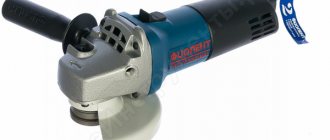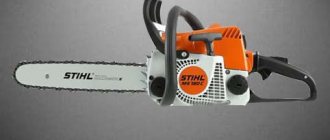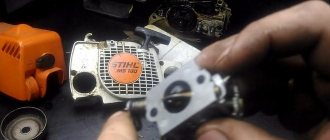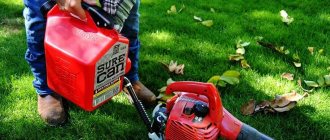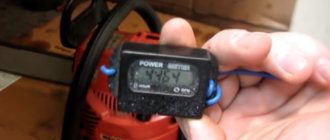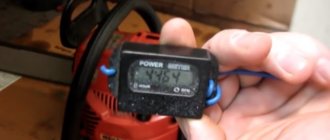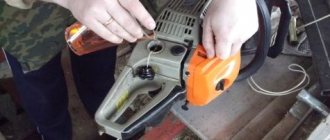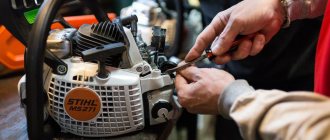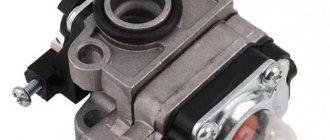Types of chainsaw malfunctions
Almost any hand-held gasoline tool has a two-stroke engine as its power unit. These engines have advantages over four-stroke ones. They have less weight with the same power. But at the same time, they received disadvantages in the form of adding oil to gasoline and lower efficiency. There are several main malfunctions in the operation of the saw:
- The engine does not start. Starting a cold engine and a hot one are different. To start a cold engine, a choke is activated, which reduces air intake and increases the percentage of gasoline in the fuel-air mixture.
- The chainsaw starts and stalls, never reaching the required speed. You have to constantly work the throttle trigger, maintaining high speeds.
- The engine stalls when operating under load and does not develop optimal power.
Malfunctions can be caused by both mechanical reasons and problems related to electrical equipment.
Power system: incorrect fuel mixture
Two-stroke engines are designed to run on a mixture of gasoline and oil, which is needed to lubricate the cylinder-piston group. Lack of oil will quickly damage the tool and lead to major repairs.
In gas-powered tools from different manufacturers, the ratio of oil to gasoline is 1:40 or 1:50. This proportion must not be violated under any circumstances. If you pour more oil than necessary, this will lead to coking of the piston compression rings. They will lie tightly in their grooves, and the engine will lose compression and power.
The only exception is the tool running-in mode. In this case, the mixture is made 1:25 and is used for a short time, with minimal load.
Signs of an excess of oil in gasoline are as follows: the chainsaw stalls, smokes profusely, and does not develop power.
Sources:
https://zemlyaselhoz.ru/pily/benzopila-shtil-ne-nabiraet-oboroty-prichina.html https://specmahina.ru/benzopila/STIHL-ne-zavoditsya.html https://armatool.ru/pocemu- pila-stil-180-ne-razvivaet-oboroty-priciny-i-remont/
Refusal to work
The Shtil 180 chainsaw, the faults of which you can identify and repair yourself, sometimes simply does not start. This problem can arise completely by accident. First of all, the consumer needs to open and close the gas tank cap again. Ventilation of the combustion chamber must be carried out in the next step.
It is recommended to remove the candles and dry them well. In some cases, this is enough for the tool to start and work properly. If the problem remains, then the reason is different. The breather affects the fuel supply. If it becomes clogged, a vacuum occurs in the fuel tank, which results in failure of operation. The breather can be repaired very simply. To do this, it is cleaned with a needle.
If you purchased a Shtil 180 chainsaw, you can find and repair this tool yourself. Sometimes equipment fails to work because the cylinder fails. If there are unevenness and chips on this unit, then this is definitely the reason. If you encounter a problem where the tool does not start, holds power for a short time, or stalls after turning on, then the muffler may be causing the problem. During operation, it sometimes becomes clogged with deposits that occur during exhaust.
The saw sometimes has difficulty starting, which is caused by starter malfunctions. In order to identify the problem, it is necessary to remove the cover and a special screen from the carburetor, which is located behind the tool drum. If the contact wire is disconnected from the starter, it is fixed with a blowtorch. Sometimes the problem is an oil leak. In this case, the starter must be wiped with a rag.
Why does the chainsaw immediately stall and choke when you press the gas?
Chainsaws are fairly reliable and simple designs. Therefore, if you properly care for them and handle them based on the manufacturer’s recommendations, then they fail very rarely and various types of breakdowns are quickly eliminated. But if you are faced with this situation and want to repair your instrument yourself, without resorting to the help of professionals, then delve into the information presented below.
In fact, it is impossible to unambiguously and accurately determine the reason why the tool does not start or stalls when you press the gas, since there are quite a lot of factors influencing this. But do not forget that starting from the fact that the chainsaw is equipped with a simple two-stroke engine, such conditions as lubrication, fuel, spark and air are important for its effective performance.
Consequently, the carburetor directly prepares the fuel-air mixture, the filter cleans the air from dust, the ignition unit and spark plug create a spark, and the gasoline contains lubricant.
That is why it is necessary to search for the causes of this kind of breakdown in a sequential order, starting directly from the simple ones and gradually moving to the complex ones. And this is an important factor in proper repair, since the person who, without thinking, begins to disassemble the carburetor, puts it at risk. Since this kind of unit must be repaired or adjusted directly in special workshops (read about carburetor adjustment).
Wrong fuel
An important fact is that for trouble-free operation of the tool it is necessary to pay close attention to the fuel itself . Since if this kind of mixture is not prepared correctly, then most chainsaws simply will not start. Consequently, not every owner will think to look for the cause of the breakdown in the fuel. That is why, in order for your tool to always work correctly, you need to use only high-quality gasoline for the mixture.
And also use only the oil that is made by the manufacturer of your tool. In addition, it is important to prepare this kind of mixture in the amount that you will definitely use in one or two weeks, but no more (see the proportion of gasoline and chainsaw oil).
Because otherwise, overexposure of the mixture directly in the canister will lead to it losing all its octane properties and this will lead to significant problems with the instrument.
Filling the mixture when the mechanism is running
The cause of a breakdown can also be the direct pouring of the mixture into the spark plug at the moment when the mechanism is started . In order to solve this problem, you need to turn out and dry the candle, but remember that it should not be heated under any circumstances. Excess fuel must be drained through the hole (spark plug), wait 20-30 minutes, then put it back in place and try to start the tool again.
There is no spark and the chainsaw does not gain momentum
The chainsaw stalls when you press the gas because there is no spark . This can happen when there is no good contact between the tip of the spark plug and the wire (high voltage). However, if this kind of connection works correctly, but there is still no spark, then the ignition unit (electronic) is the cause. It is important to note that these types of spare parts cannot be repaired, so they can only be replaced.
Do not forget that by examining the spark plug you can obtain significant information regarding the breakdown of the chainsaw. Since if its surface is dry, then the reason for this is the cylinder, into which fuel is not directly supplied. That is why you will have to check the entire range of its supply step by step. If the spark plug is covered in black soot, this means that the carburetor is not working properly, that is, it supplies either a lot of fuel or pours oil directly into gasoline.
Read also: What is made of aluminum
There is not enough fuel to supply and operate the chainsaw at full power
If the chainsaw stalls when gas is added, this means that there is not enough fuel supplied for the chainsaw to fully operate . The reason for this may be either a clogged carburetor (its jet) or contamination of the filter itself (fuel). Remember that the first unit should be checked exclusively by professionals, but you can clean the second one yourself.
Filter is dirty
In addition, the cause of breakdown can be the filter (air) if it is contaminated with dust . But do not forget that each model has its own easily eliminated and characteristic features. It is for this reason that do not hastily start disassembling and repairing the instrument, but it is best to “walk” through the forums, where there are a huge number of reviews from various owners, so as not to make things worse.
Since, for example, a Stihl chainsaw stalls when you press the gas for a simple reason, namely a simple clogging of the direct breather.
In order to solve this kind of problem, all you have to do is disconnect the (fuel) hose from the carburetor and pay attention to whether fuel is leaking out of it. Since if the mixture flows in a full stream, this means that the breather is not contaminated, but if on the contrary, then the cause of the breakdown has been found.
Muffler as the reason why the saw stalls under load
Here is another reason why a chainsaw stalls when you press the gas - muffler . It is this part that can interfere with the full operation of the tool in cases where it is directly contaminated with exhaust resinous deposits. To do this, you just simply need to clean it.
Cylinder-piston group
Quite often the partner chainsaw stalls when pressed and the reason for this is the cylinder-piston group . Since by examining them, namely the piston and cylinder, you can easily determine the cause of the tool malfunction by directly replacing them. You can also directly bore the cylinder itself relative to the dimensions of the new piston.
But if after inspection you find that there is no damage on both the piston and the cylinder, then the reason may lie directly in the rings (piston). To do this kind of check, you need to insert a piston into the cylinder and carefully begin to rock it using a connecting rod. If you suddenly feel play, then the rings need to be replaced, as they are already worn out.
Insufficient chain lubrication prevents starting and the saw does not develop speed
Many people wonder: why does the chainsaw stall when I press the gas? The answer may also lie in insufficient chain lubrication (see chain saw oil), since the oil line may be leaking, or the direct channels may simply be clogged. That is why pay attention to the chain, because if it is dry, then without delay, start cleaning the channels that supply oil directly to the tool tire. Then inspect in detail the parts where the oil pump fittings are connected to the pipes. But if you notice that oil is leaking at the joints, or you find cracks in the tubes themselves, then in the first case, seal the leaks with sealant, and the tubes will have to be replaced.
Troubleshooting a chainsaw carburetor
Remove the carburetor from the chainsaw. Remove the fuel pump cover with the membrane by unscrewing one screw in the center of the cover. Next, turn the carburetor towards you with the throttle valve, on the side where there are two holes, in one you can see a pin, and under it there is an accelerator pump. Remove the retaining ring from the outside of the pin and disconnect the wire spring of the air damper. Unscrew the screw in the center of the throttle valve, remember how the throttle valve is positioned (so that you can put it that way later) and remove the throttle valve. Plug the hole with the pin with your finger (the accelerator is spring-loaded and if you remove the throttle axis and do not close the hole, the accelerator will pop out), then turn the throttle axis and remove it. Shake the accelerator (piston) with the spring out of the hole. There is a rubber cuff (ring) on the piston - its wear is what causes the chainsaw to malfunction. It is necessary to replace the piston with a rubber cuff and a spring (they are sold as a repair kit). Or you can remove the worn piston with the spring, and plug the hole by pushing a rubber plug in there (the chainsaw will not have an accelerator pump, that is, it will accelerate not in 3 seconds, but in 4 seconds, but it will work well since there will be no suction air from the carburetor).
Assembly after troubleshooting the chainsaw (after eliminating the malfunction of the chainsaw carburetor) is carried out in the reverse order of disassembly. When assembling the throttle valve, before tightening the screw, the throttle valve itself must be positioned correctly so that it does not jam, and the threads of the screw securing the throttle valve to the axle should be degreased and coated with a special thread sealant (sold in small tubes, red, liquid) or flattened with pliers, because if this bolt gets unscrewed during operation, it goes straight into the cylinder) and repair or replacement of the piston cannot be avoided). So we looked at how to fix this chainsaw problem.
Reasons why Calm 180 does not develop speed
Chainsaw quiet 180 does not develop speed or after you release the throttle it continues to run without losing speed. These problems are quite common. Let's try to understand the reasons that result in the occurrence of such problems. Also in this article we will look at how to diagnose if your chainsaw is not snagging.
IMPORTANT. An experienced electrician leaked the secret to the network on how to pay half as much for electricity legally. Read more
Chainsaw Shtil stalls: reasons
If the tool turns off immediately after starting, it means that some device or part has broken down. To determine the cause, the mechanism is tested independently or in service workshops. Sometimes the reason that the mechanism does not start well is improper maintenance of the saw:
- insufficient amount of gasoline;
- poorly prepared fuel mixture;
- poor quality of lubricant;
- muffler clogged with combustion products;
- unadjusted carburetor;
- obstruction of the air filter;
- piston or cylinder failure.
When you press the gas
The sawing units operate at idle speed, but the chain saw stalls when the gas is pressed, as the load increases. Before use, warm up the tool by running the engine at idle speed for a minute. If this is neglected, the motor stops after pressing the pedal. Other reasons may be:
- clogged or unregulated fuel mixing unit;
- a clogged air filter does not provide the required air flow when the load increases;
- a dirty gasoline filter does not allow the required amount of mixture to pass through;
- the cylinder and piston walls rub.
A low octane number of fuel causes brakes, since this circumstance prevents the engine from achieving the required power when the load increases.
At idle
Violation of the functionality of the fuel unit system leads to air leaks. In this case, the unit stalls at idle and does not maintain its number. Additional suction reduces the air impulse to the fuel pump and passes through the sump membrane or crankshaft seals. Diagnostics is done with a vacuum gauge.
Stopping the engine when cold occurs for other reasons:
- the spark plug channel contains an excess amount of combustible mixture;
- the gap between the tip of the spark plug and the high-voltage cradle is not adjusted;
- power supply failure.
Check the seals by pouring gasoline into the crankcase; the leak is visible visually. This means that the engine does not operate at idle speed, and at high frequencies, leaky oil seals will lead to bearing jamming. If elements leak, they are replaced with new ones and sealed.
Full speed ahead
Sometimes the engine stalls after normal operation
To establish the cause, pay attention to the accompanying circumstances:
- The engine stalls in the middle of operation for no apparent reason. The starter is in a stationary position and does not turn. This means that the tool is jammed and requires urgent repair.
- During normal operation, power decreases in a short time and the engine stops, the cylinders are overheated. The situation indicates an air leak under the rubber pipe between the carburetor cylinder, possibly due to a rupture. The air becomes depleted of fuel; the pipe needs to be replaced.
Not gaining momentum
Many mechanism systems are involved in the startup, so the loss of speed of the Stihl chainsaw after idling can be a consequence of various factors. Reliable idling and interruptions in the engine under load can occur for the following reasons:
- development of engine life;
- wear, deformation and corrosion of the piston group;
- malfunction of the ignition coil or spark plug;
- unbalance of carburetor screws.
If the tool does not develop speed, then the conductivity of the hole in the fuel tank cap is impaired. The occurrence of a vacuum does not provide the required amount of fuel, so the engine does not gain the required power. The speed decreases when carbon dioxide accumulates in the muffler, and the removal of combustion gases is difficult.
Doesn't slow down
The tool quickly reaches maximum speed without losing power. This situation is explained by the fact that:
- the throttle valve does not work due to a weakened spring or traction element;
- the switch on switch periodically fails;
- there is no corkscrew on the throttle axis;
- the carburetor is clogged;
- The fuel hose and gasoline filter are not functioning properly.
The main reasons why a STIHL chainsaw does not start and how to eliminate them
German saws STIHL (STIHL) have long established themselves as high-quality and reliable cutting tools. For various needs, the company offers a wide range of models:
- Low-power chainsaws for working in the garden or in the country for pruning bushes and felling trees with a small diameter trunk, preparing firewood: MS 170 (1.3 kW), MS 211 (1.7 kW), MS 230 (2 kW) and others.
- Medium power chainsaws, ideal for farmers, gardeners and construction workers: MS 271 (2.6 kW) and MS 310 (3.2 kW).
- Super-powerful saws with a gasoline engine, characterized by high performance and suitable for all industrial and economic work related to the processing of wood of various hardnesses: MS 361 (3.4 kW), MS 361 (5.2 kW) and others.
- Electric and battery-powered saws that do not require fuel to operate, but are also perfect for working in small gardens: for example, MSE 250 CQ or MSA 220 CB (with AP 300 S and AL 500).
The lightweight and compact model of the tool is used for household purposes, but despite its optimized performance, sometimes the STIHL chainsaw does not start. Problems manifest themselves in the fact that the engine starts and stalls, is unstable, cannot develop the required power, or suddenly gains high speed.
The chainsaw does not develop speed: we test the device for malfunctions
The ignition module can be diagnosed for problems visually. To do this you need:
- turn out the spark plug;
- evaluate its appearance (it should not be filled with gasoline or contain a black coating);
- check the distance between the coil and magnets (up to 0.2 mm);
- if necessary, examine the spark plug block for spark supply using a working power cable.
If after checking no defects were found, you should proceed to checking the carburetor unit.
This working unit is one of the most vulnerable in modern chainsaws. New tools that go on sale from the factory have basic settings for low and high speeds, which must be reinstalled after running in and running in all the parts. Similar actions are performed if the saw does not develop traction corresponding to the maximum torque according to the instructions.
Try also growing Black Prince tomato in your garden.
In this case, you need to reconfigure one of them - the “H” jet, which is responsible for the operation of the saw under load. To do this, it is enough to adjust the fuel supply with the engine running at the highest chain rotation speed, using the tachometer and the operating instructions.
Why doesn't the chainsaw gain momentum?
Starting up is a complex multi-level process in which almost all life support systems of the saw are involved. That is why the fact that the chain saw loses speed, turns on intermittently and feels confident only at idle should be considered from different angles.
- a faulty motor - its service life could be exhausted, and the piston rings and cylinder could wear out, become deformed, or even succumb to corrosion;
- a faulty spark plug or the coil itself - as a result, the spark necessary to ignite the air-fuel mixture is not produced;
- unbalance of the carburetor screws, as well as a number of reasons that could cause it to fail.
Why does it stall at full speed?
Very often you can hear the question why a chainsaw stalls at full speed. There may be several reasons. First, you need to consider exactly how the saw stalled. Let's say the tool was working normally and suddenly, for no apparent reason, it suddenly stalled and the starter does not turn over. In such a situation, you can be 100% sure that the chainsaw is jammed and you need to start overhauling it.
The second situation is when the Shtil 180 chainsaw worked normally, then gradually lost power in a short time and stalled, and the cylinder overheated. In this case, the most likely reason is air leakage under the rubber pipe connecting the carburetor to the cylinder or its rupture. The mixture became lean, resulting in overheating. The cause can be eliminated by changing the pipe.
Cleaning the fuel filter
If there is insufficient fuel supply, the chainsaw stalls when accelerating. The reason may be a clogged fuel filter and improper carburetor operation. How to check if the filter is at fault? To do this, you need to partially disassemble the tool body to gain access to the carburetor. Disconnect the fuel hose from it and press the fuel pump several times. On modern saws, this is a transparent rubber hemisphere that is pressed before starting the engine.
If gasoline begins to splash out of the hose vigorously, then the filter is in order. If fuel flows reluctantly, then you need to change or clean the filter.
It is located inside the gas tank, and to get it out, you need to remove the plastic protection, then use a flat screwdriver to pry off the rubber cuff through which the fuel line passes. You must remove it carefully so as not to damage the rubber. Otherwise, it will leak after installation. In some chainsaws, the filter is removed through the neck of the gas tank.
There is a fuel filter at the end of the fuel line installed in the tank. Usually it becomes clogged with tarry deposits found in gasoline and oil. The filter is pressed into the hose and can be removed by simply pulling it out. It must be washed in hot water with cleaning agents or replaced with a new one.
Air filter clogged
The main reason for a clogged air filter is fine dust generated when sawing wood. Cutting raw wood is especially hard. Of all the reasons for a chainsaw stalling, this is the most common. The exception is some models. For example, a “Calm” chainsaw stalls for various reasons, but not because of a clogged air filter. Because its carburetor is equipped with a compensator that takes in air if the filter fails.
Wood dust particles penetrate under the housing and are sucked into the filter installed on the carburetor. A clogged mesh creates resistance to air, and less air enters the carburetor.
In order to clean the air filter, it is necessary to remove the closing cover and separate it from the carburetor.
Before removing, you need to brush off the sawdust or blow with air. Then remove the filter so that debris does not get into the carburetor. During cleaning, cover the carburetor with a cloth.
Then the filter must be blown out from the inside with compressed air, and then installed in place.
Basic elements of chainsaws
Before we begin to delve into the issues of tool breakdowns and repairs, let’s first figure out what the chainsaw itself consists of. First of all, I would like to note that this tool belongs to the category of equipment whose operation directly depends on the internal combustion engine.
Single cylinder engine
In fact, a chainsaw is a fairly simple design, but this does not prevent it from being reliable, practical and capable of fully ensuring immediate uninterrupted and cyclic operation even in quite difficult conditions. This tool consists of a huge range of certain elements “vital” for its correct and productive operation. This is a carburetor, a direct chain tensioner, a tire equipped with a chain and other elements.
The chainsaw engine turns off after reaching maximum speed
The power unit stalls at high speeds due to the performance characteristics of the electronic unit not meeting the stated requirements. Failure is more typical for budget chainsaws made in China.
The reason for refusal may be:
- lack of fuel mixture in the float chamber due to valve sticking;
- clogging of the fuel filter or the breather located in the fuel tank cap.
Read also: Soldering stainless steel at home with a gas torch
The power unit also stalls at high speeds due to a dirty air intake filter. The same symptoms are typical for a situation where the chainsaw started up in standard mode and stalled during the warm-up stage.
External inspection of the spark plug
A visual inspection of a spark plug can tell you a lot about engine performance:
- A raw working part that is wrapped in a cylinder indicates a malfunction in the power system.
The fuel mixture is too rich. Carburetor adjustment required. Or the ratio of oil to gasoline is incorrect. There is more oil poured than normal and it does not have time to burn during the working stroke of the piston. Soot appears. You need to clean it off with sandpaper. Under no circumstances should you heat a candle with an acetylene or gasoline torch. After this, the inner part of the candle may separate. - Weak spark. To see the spark, you need to unscrew the spark plug. Then a high voltage wire is connected to it, the spark plug is pressed against the cylinder with its metal part. Then you need to pull the starter, and at this time look at the spark plug electrodes. A weak, unstable spark may indicate poor contacts in connection with a high-voltage wire, or an incorrect gap between the electrodes. Different spark plugs have this gap from 0.5 to 0.7 mm. As the internal electrode gradually burns out during operation, the gap increases. To restore the distance, you need to knock the outer electrode a little, or install a new spark plug.
- Spark plug depressurization. Sometimes you can notice a dark edging between the spark plug insulator and the metal nut. This indicates that the metal part has come off the ceramic. With such a spark plug, the chainsaw stalls or works intermittently. This happens because the spark strikes the cylinder through the spark plug body. Depressurization can occur with a cheap, low-quality spark plug, or if it was over-tightened at the time of installation.
Additional Tips
First of all, what you should remember when purchasing this kind of tool is that certain parts of the saw need to be replaced with new ones after their service life (passport) has expired. It is for this reason that the instructions should always be at your fingertips, since everything is described there in detail.
These types of parts include: a sprocket (drive), a tire, part of the system (anti-vibration), and also a chain. Since we should not forget that if this “filling” is not replaced with a new one at the required time, then these worn-out spare parts will negatively affect the remaining parts of the chainsaw. It is for this reason that you should check the depth of the immediate tooth cutting quite often. Remember that it should not be higher than 0.5 mm a week.
What to do if the chainsaw does not idle?
Problems with idle speed are considered constant companions of chainsaws. There may be several prerequisites that could lead to stalling at the time of start-up and cranking of the chain when idling, the main ones being:
- air and gasoline filters are clogged;
- poor quality fuel mixture or improper preparation;
- problems with the ignition module;
- a carburetor whose settings no longer correspond to the load on the saw;
- motor elements are deformed or rusted.
A series of actions are performed sequentially:
- wash the fuel hose or replace it with a new one,
- Clean the air filter, which could be clogged with sawdust and dirt particles. Modern air filters are reusable, they can be washed with the addition of detergent, completely removing them from the saw body;
- check gasoline and motor oil, which may be of poor quality or simply not suitable for working with this saw;
- testing spark plugs and carburetor.
Eliminating one or more possible problems will usually restore the saw to its former strength.
The engine runs intermittently
You can begin to identify malfunctions of the Shtil 180 chainsaw yourself if the warranty period has expired. Sometimes the engine runs intermittently, which can be caused by a failure of the cylinder piston group. You can repair it yourself. To remove the cylinder from the tank, it is necessary to unscrew the bolts on its head. The technician should check the piston; there should be no chips, scratches or burrs on it. If any can be found, then the piston must be replaced.
Piston rings and piston ensure optimal pressure in the combustion chamber. The rings must fit tightly onto the piston body. If the piston inserted into the cylinder has free movement when rocking, then this indicates its wear. To fix the problem, it is necessary to bore the cylinder and install repair parts. But the easiest way would be to replace the CPG kit.
Muffler
You may ask, what is the first one? The answer is a muffler. The muffler is responsible for releasing exhaust gases and extinguishing their flame. All combustion products pass through it, which over time can clog it. The situation with a muffler clogged with soot is far from unique, and it occurs due to incorrect fuel consistency.
With the usual ratio of gasoline to oil, the combustion products are not so saturated with soot that they clog the muffler. In this case, if the amount of oil is more than normal, excess carbon deposits appear when it burns. Further, carbon deposits accumulate under the piston rings and in the muffler of the Shtil 180 chainsaw. Disassembling the Stihl chainsaw does not gain speed when you put pressure on the saw. Thus, a coked muffler is the safest thing that can happen; the greatest harm from excess carbon deposits is the need to replace the piston.
Carburetor malfunctions
If you purchased a Shtil 180 chainsaw, you can detect and carry out carburetor malfunctions and repairs yourself. If the tool stops starting, begins to stall and is unable to maintain power, and also does not hold idle speed, then the carburetor may be the cause of the breakdown. During operation, it quite often becomes clogged with dirt, dust or sawdust. The problem can be resolved by cleaning it.
Malfunctions of the carburetor of the Shtil 180 chainsaw can be resolved after preparing some tools, including:
- brush;
- head at 8;
- crosshead screwdriver;
- petrol.
A brush can be used to clean away dust and dirt. Then remove the cover and filter. The two nuts of the air filter are unscrewed, which will allow you to remove the air collector housing. You should now be able to see the carburetor. After lowering the throttle down, you need to remove the accelerator lever.
In order to move the carburetor, it is necessary to remove the choke lever and close it. Now you should remove the engine stop wire and pull it towards you. The plastic lever is removed and the wire is fixed to it. At this stage the carburetor can be released and removed for cleaning. It is best to use a compressor for this, but if one is not available, flushing can be done with pure gasoline.
When considering the main malfunctions of the Shtil 180 chainsaw, you should know that you should not forget about the fuel filter. It is removed and the fuel hose is blown out. Now you can put everything back together in reverse order. If, after assembling the carburetor, the tool still does not start well and the muffler produces smoke, then the spring under the needle lever has been lost. Due to its absence, the needle does not shut off the fuel supply. As a result, the spark plug is flooded with gasoline. To fix this problem, you need to find the spring and install it in place.
When repairing a carburetor, you must remember that it is a complex unit consisting of rings and many parts. This indicates that cleaning and repairs must be carried out with extreme care. If the tool stalls or does not start, then, in addition to the carburetor, it is necessary to check the spark plugs. If they are faulty, they are unscrewed and dried.
Excess fuel can be drained through a special hole. Malfunctions of the Shtil 180 chainsaw and their elimination are partially described in the instructions. After reading the article, you can understand that the candles should be dried for at least half an hour; after this time, the candle can be replaced in place by starting the unit.
Carburetor depressurization and injector clogging
Sometimes, when the carburetor cover screws are loose or the gaskets are unusable, loss of power can also occur on the chainsaw, to rule out the possibility of this malfunction, it is necessary to check the integrity of the gaskets and tighten the screws on the carburetors. To do this, remove it from the engine (algorithm described above) and disassemble it. Defective gaskets must be replaced using spare parts from the SMI 180 carburetor repair kit.
In the case where a complete check of the fuel supply and exhaust system has been carried out, but there are no results. The main fuel injector valve needs to be checked. To check, you need to knock it out of the carburetor body. All work must be performed according to the following algorithm:
- The carburetor is removed from the chainsaw.
- Four screws are designed to secure the cover with the compensator, after which the cover can be removed.
- The carburetor is mounted on a wooden lining, then with a bolt with a diameter of no more than eight millimeters and a length of 50, it is knocked out into the internal cavity of the carburetor.
- Next, you need to select a small hose whose inner diameter is equal to or slightly smaller than the outer diameter of the injector, and put it on the nozzle.
- The next step is to hit the inside of the hose. If it only blows in one direction the nozzle is fine, if it blows in both or not at all the valve needs to be replaced.
All of the above steps should help in eliminating the problem that the chainsaw does not pick up speed, otherwise it will help to carry out a full diagnosis at the manufacturer’s service center.
Calm 180. Classic of the genre. Doesn't develop speed
In order to clean the mesh filter, you need to remove the carburetor from the Shtil 180 chainsaw. The work begins by removing the top cover of the saw, after which, using an 8 mm socket, unscrewing two fastening nuts. Next, the filter housing is removed from the guides, after which the air damper rod and the engine control lever are disconnected. Lastly, the fuel hose and throttle linkage are disconnected, after which the carburetor can be removed from the guides.
The carburetor strainer is installed in the fuel pump chamber; in order to get to it, one screw securing the pump cover is unscrewed and it, along with the gaskets, is removed.
The mesh filter can only be cleaned using compressed air. Any mechanical methods are strictly prohibited, because the mesh is very soft and simply changes shape. Answer: chainsaw calm 180. Repair and treatment of childhood diseases. There is a spark, gasoline is flowing, because... The spark plug is wet, but the saw won’t start. How to treat it. When you press it, it simply wrinkles and bends form along the edge of the landing site, through which unfiltered fuel can enter the carburetor.
During the cleaning process, you need to cover the landing site with the filter installed in it halfway with your finger and only then blow with air, otherwise the mesh may fly away and it will no longer be possible to find it.
Why does it stall at idle?
Related Posts
The first and most common cause of this malfunction is incorrect carburetor adjustment. You can adjust the idle speed yourself; for this you need to have a Stihl adjusting screwdriver, which is supplied with the unit. The adjustment hole is located on the right side of the Shtil 180 saw on the handle and is indicated by the symbols “-” and “”.
If the Shtil does not hold speed and stalls at idle
, you can be almost 90% sure that there is a problem with the fuel pump; as a rule, this is air leaking into the crankcase through the pan gasket, or, more often, through the crankshaft seals. Air leakage reduces or completely stops the impulse, which is supplied through special channels to the fuel pump of the chainsaw. As a result of this, the Stihl 180 chainsaw does not receive the required amount of fuel and stalls at idle.
Diagnostics can be carried out using a special device called a vacuum gauge.
The Stihl 180 chainsaw does not pick up speed and stalls.
The second way to check the performance of the oil seals is to pour gasoline into the engine crankcase and look at them; if the oil seals leak gasoline, it means they cannot provide normal pressure in the crankcase, which will make idling impossible. And when operating at high speeds, with leaky oil seals, there is a possibility of the crankshaft bearings jamming.
The algorithm for checking the Shtil 180 crankcase and seals for leaks is as follows:
- The top cover is removed.
- The air filter housing and carburetor are dismantled.
- The chainsaw handle is removed.
- The starter spins up and retracts.
- On the side opposite the starter, the side cover and drive sprocket are removed.
- A piston stopper is installed in the spark plug hole or a string from an old starter with knots tied on it is stuffed into the cylinder.
- The flywheel and clutch are unscrewed, after which the parts are removed. It is worth knowing that the chainsaw clutch has a left-hand thread and unscrews clockwise.
- The oil pump drive gear is removed.
Having disassembled the Stihl MS 180 chainsaw, you can see the oil seals, after which you need to fill the crankcase with gasoline and check for leaks. The crankcase can be filled through the fuel window in the cylinder; to do this, the piston must be raised as high as possible. If leaks are detected, it is necessary to replace defective oil seals or re-seal the pan. You can assemble Shtil 180 by following the reverse sequence of the algorithm.
Calm 180 does not pick up speed and stalls.
The chainsaw does not gain momentum: an overview of the reasons and do-it-yourself repairs
Malfunctions occur both in expensive German or American modifications of chainsaws, and in their cheap Chinese counterfeits. It’s nice when the power tool starts up smoothly: the saw warms up and gradually reaches the rated power declared by the manufacturer, which is provided throughout the entire operating cycle. Things are worse if everything happens the other way around: after pulling the gas cable, the unit begins to slip, runs jerkily after short pauses, stalls and restarts with the pusher.
There can be many reasons for this phenomenon, as well as scenarios for the development of events. Let us consider in detail each working situation and the breakdowns that preceded them.
Conclusion
When the first signs of loss of power (reduction in speed) of the KS 180 chain saw are detected, under no circumstances should you continue to operate it and you should immediately contact a specialist or carry out diagnostics and repair the fault yourself. There are not many reasons for losing power, and you can even cope with them even without certain skills. The main thing is to calmly analyze the behavior of the saw and find out the reasons why it stopped pulling (the speed has dropped), and it is no longer easy to correct the malfunction.
Modernization does not stand still. And the old chainsaws, which in addition to being able to only cut wood, emitting a terrible roar and vibration that could be heard almost kilometers away, are long gone. Almost silent, thorough tools that are now a pleasure to hold in your hands have flooded the market, giving users a feeling of complete happiness and technical freedom.
But, unfortunately, no matter how technically and visually advanced the advanced technology is, its breakdowns are a fairly common occurrence, which manufacturers talk about only “by default.” Chainsaws are no exception to this, multifunctional working units that require enormous attention from the user in order to recognize the “catch” in time and stop the problem at the earliest stages.
The main of these nuances usually relate to the moment of launch, which should be taken with full responsibility. Let's look at the main processes that can occur with a chainsaw when the engine is turned on.
The saw does not develop speed, does not develop power.
A Shtil 180 chainsaw was brought in for repairs.
.
Chainsaw Shtil 180 does not develop
speed. After visual inspection
Installation of the Ergostart easy start system into the tool, equipment with a quick tensioning device for the cutting chain, an electronic ignition system - these modern innovations are more common in semi-professional chainsaws and are not typical for the Stihl
, nicknamed “hobby class” in Europe. The rival Oleo-Mac 937 is equipped only with an electronic ignition system, while the Husqvara 137 only has the LowVib anti-vibration system.
Vibration neutralization is achieved by four shock absorbers made of dense, elastic rubber. Vibration indicator 4.3-7.2 m/s 2. For comparison: chainsaw
of a similar lightweight class, Husqvara 137 produces a vibration characteristic of 4.9-7.7 m/s 2 and this is with an anti-vibration system. And the Oleo-Mac 937 model gives a vibration level of 5.2-5.5 m/s2.
